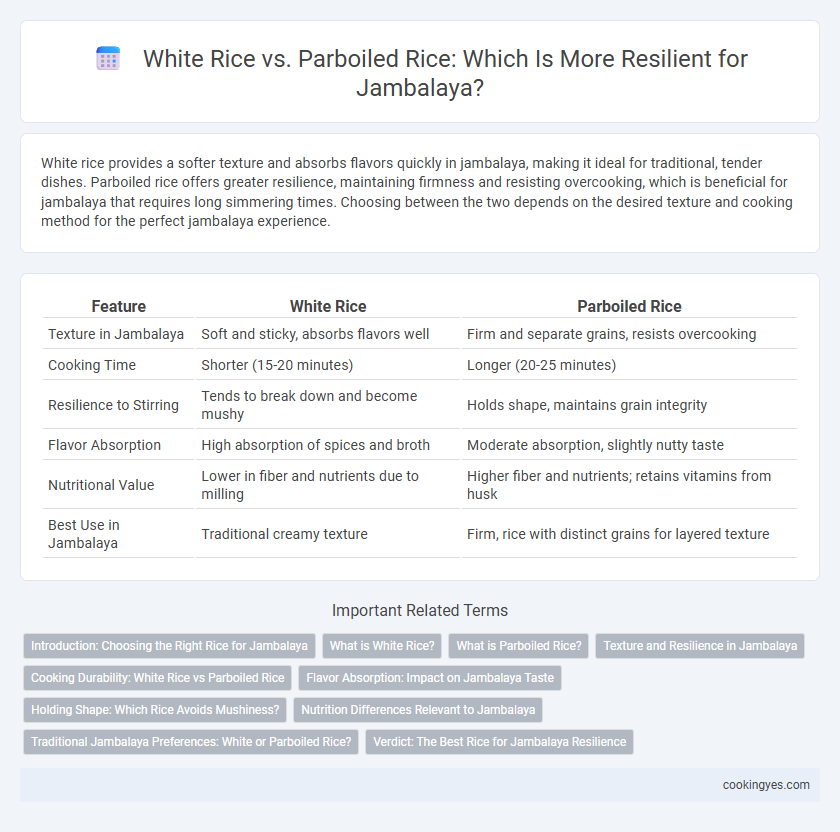White rice provides a softer texture and absorbs flavors quickly in jambalaya, making it ideal for traditional, tender dishes. Parboiled rice offers greater resilience, maintaining firmness and resisting overcooking, which is beneficial for jambalaya that requires long simmering times. Choosing between the two depends on the desired texture and cooking method for the perfect jambalaya experience.
Table of Comparison
| Feature | White Rice | Parboiled Rice |
|---|---|---|
| Texture in Jambalaya | Soft and sticky, absorbs flavors well | Firm and separate grains, resists overcooking |
| Cooking Time | Shorter (15-20 minutes) | Longer (20-25 minutes) |
| Resilience to Stirring | Tends to break down and become mushy | Holds shape, maintains grain integrity |
| Flavor Absorption | High absorption of spices and broth | Moderate absorption, slightly nutty taste |
| Nutritional Value | Lower in fiber and nutrients due to milling | Higher fiber and nutrients; retains vitamins from husk |
| Best Use in Jambalaya | Traditional creamy texture | Firm, rice with distinct grains for layered texture |
Introduction: Choosing the Right Rice for Jambalaya
White rice offers a soft texture that absorbs flavors well, making it a traditional choice for classic jambalaya recipes. Parboiled rice, with its firmer grains and higher nutrient retention, provides greater resilience against overcooking and better maintains its structure during long simmering. Selecting between white and parboiled rice impacts the dish's texture and cooking consistency, crucial for achieving authentic jambalaya results.
What is White Rice?
White rice, a refined grain with the bran and germ removed, offers a softer texture and quicker cooking time ideal for traditional Jambalaya dishes. Its starch content makes it absorb flavors well but can result in a stickier consistency compared to parboiled rice. This characteristic influences the resilience of the dish, providing a tender base that complements the rich mix of meats and spices typically found in Jambalaya.
What is Parboiled Rice?
Parboiled rice is partially boiled in the husk, which drives nutrients from the bran into the grain, making it more nutritious and firmer than white rice. Its resilience to overcooking and ability to remain separate when cooked make it ideal for jambalaya, where texture and grain integrity are essential. White rice tends to be softer and stickier, which can result in a mushier jambalaya if not carefully managed.
Texture and Resilience in Jambalaya
Parboiled rice offers superior resilience in Jambalaya due to its firmer texture and enhanced ability to absorb flavors without becoming mushy, making it ideal for the dish's rich, saucy consistency. White rice, while softer and quicker to cook, may result in a less structured texture that can break down under prolonged simmering, affecting the overall integrity of the Jambalaya. Choosing parboiled rice helps maintain distinct rice grains and a perfect balance of chewiness and flavor absorption crucial for an authentic Jambalaya experience.
Cooking Durability: White Rice vs Parboiled Rice
Parboiled rice offers superior cooking durability for jambalaya due to its firmer texture and reduced stickiness, which helps maintain grain integrity during extended simmering. White rice, while more traditional, tends to become mushy and breaks down faster when exposed to the long cooking times required for jambalaya. Choosing parboiled rice enhances the dish's consistency and prevents overcooking, ensuring a more resilient and visually appealing jambalaya.
Flavor Absorption: Impact on Jambalaya Taste
White rice absorbs flavors more effectively, enhancing the authentic taste of jambalaya by soaking up the spices, broth, and meats thoroughly. Parboiled rice retains a firmer texture but absorbs less seasoning, resulting in a less intense flavor profile. Choosing white rice optimizes flavor absorption, crucial for achieving the rich, layered taste that defines traditional jambalaya.
Holding Shape: Which Rice Avoids Mushiness?
Parboiled rice is superior for jambalaya when it comes to holding its shape and avoiding mushiness due to its partially boiled processing, which strengthens the kernel and reduces starch release. In contrast, white rice tends to absorb more liquid and breaks down more easily, resulting in a softer, sometimes mushy texture. Chefs favor parboiled rice in jambalaya recipes to ensure distinct, firm grains that maintain the dish's integrity during simmering and reheating.
Nutrition Differences Relevant to Jambalaya
White rice offers a softer texture that absorbs the bold spices of jambalaya well but has lower fiber and essential nutrients compared to parboiled rice. Parboiled rice retains more vitamins such as B-complex and minerals like magnesium due to its steam-pressure processing, enhancing the nutritional profile of jambalaya. Its firmer grains resist overcooking, maintaining dish structure during long simmering, which improves jambalaya's overall resilience and mouthfeel.
Traditional Jambalaya Preferences: White or Parboiled Rice?
Traditional jambalaya recipes typically favor white rice for its soft texture and ability to absorb the rich flavors of the dish, ensuring a tender, cohesive outcome. Parboiled rice offers greater resilience during cooking, holding its shape and resisting overcooking, which benefits jambalaya consistency in longer cooking processes. Culinary experts often debate the balance between white rice's flavor absorption and parboiled rice's structural integrity when perfecting authentic jambalaya.
Verdict: The Best Rice for Jambalaya Resilience
Parboiled rice offers superior resilience for jambalaya due to its firmer texture and ability to absorb flavors without becoming mushy, enhancing the dish's overall consistency. White rice, while traditional, tends to break down more easily during cooking, potentially resulting in a softer, less structured jambalaya. For a robust, well-textured jambalaya, parboiled rice is the optimal choice, ensuring each grain remains distinct and flavorful.
White rice vs Parboiled rice for Jambalaya resilience Infographic

 cookingyes.com
cookingyes.com